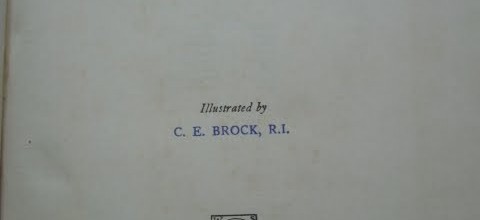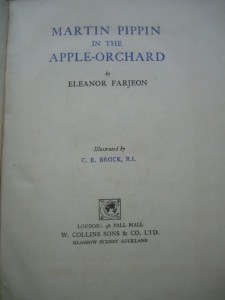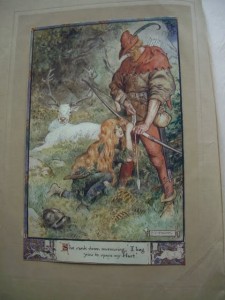
Well, here’s a new idea!
On the other side of several little surprises, like being nominated for an award and then being shortlisted for the same award (many thanks to all who voted) I was reminded to go back to that book of childhood memory: Martin Pippin in the Apple Orchard, that I mentioned in September.
It’s a really peculiar book, part local folklore, part children’s story, part tales within a tale (like Chaucer) and part play (like J M Barrie) and with a sophisticatedly mercurial protagonist linking the plot, sub-plots and sub-sub-plots.
What’s utterly strange about the book is the parts do not add up to a whole. The eponymous Martin tells six tales – one of them truly surreal: a dream sequence that could have been written by a psychiatrist dealing with a romantic psychosis – to persuade Gillian to marry Robin who loves her. But several of the tales, not just the psychiatric dream one (which includes a drowning, an abusive father and a daughter who appears to be both autistic and reclusive, in modern terms) are reversals of romance; they deal with the unfulfilled, the unconsummated and the unbearable forms of love. Not exactly what you’d expect from a children’s book.
I first remember reading it when I was seven. Between seven and eleven I kept the book with me most of the time, which was odd, because it was a school library book and I was constantly being sent notes through my class teacher to ask me to return it. I then wasn’t allowed to borrow it again for 24 hours and if anybody else got their hands on it during that time I would suffer for a fortnight before it appeared on the shelf again. You might have thought my parents would have bought me a copy but it doesn’t seem to have occurred to them. In truth, my book-reading was pathological – they may have felt it was better not to encourage my obsession.
So, a couple of years ago I bought a copy. Not the library copy, which had some kind of line drawings adapted from the original, but the December 1926 edition with the lush original paintings by C E Brock, RI. Brock was obviously in his conflicted phase at the time he drew these; wavering between his prim Victorian approach and his detailed (and somewhat grotesque) coded sensuality – look at Proud Rosalind’s hands on the Red Smith’s weapon!
Anyway. I re-read it. And a penny dropped with a big, 1926 style clang, not a modern tinny tinkle. The book is set in Sussex. And I live in Sussex.
So I have a quest for 2012 – to try to find every place that Farjeon mentions in the book; I already know some: Nyetimber is Newtimber, one of my favourite haunts, for example. But others I have never heard of, and it will be an exercise of history and ingenuity to locate them. The first place name in the book is Adversane, so that’s where I’m starting. At the time Farjeon wrote it had a thriving community with a strong local folklore (or so she claimed). Now it has a pub and a breaker’s yard (or so Google claims). I shall go and find out for myself and I shall do it between Christmas and New Year!
I am intending to rope friends into this bizarre pastime, so if you fancy a bit of sleuthing, along with a trip to a remote Sussex hamlet, let me know, and I shall sign you up for Pilleygreen or Earthen Wood, Tegleaze or Malecomb …




10 Comments
Charles Lambert
11th December 2011This would almost be worth moving back to the UK for (even if it no longer part of Europe…)
Kay Sexton
11th December 2011Charles, if you’re visiting, then surely you can fit in a quick Farjeon-jaunt, sometime?
Charles Lambert
11th December 2011I would love to. I’ll do my best…
Gallant Press
11th December 2011I wish that I had the money and free time to help. This is exactly the type of project that I would love. Keep us posted.
—Peter Spenser
Esther Montgomery
11th December 2011There was a book called ‘The Cuckoo Clock’ in my Junior School library. I didn’t have it out on permanent loan but its presence there made life alright. It was old, with thick, yellowish pages which had had to be cut before it was first read. The cover was blue. I can’t remember the story. I’ll have to check up on that. But I’m pretty certain it was magical.
Found art blog
12th December 2011OH CAN I COME???! I have time off work for good behaviour between Xmas and New Year (aside from 28th Dec – other plans!) Mememememememeemeeeee!!! (And Andrea too, because she says I’m too small to go out on my own!)
Kay Sexton
12th December 2011Gallant Press, I wish you could play too – it’s the kind of game you ‘get’ or you don’t.
Esther – search Abe Books, I’ll bet it’s there!
Beanie – yes of course. Although perhaps you’d like the jaunt to Moulsecombe best, as it’s almost ‘mouse’ …? And Andrea can come too, if she behaves herself.
Found art blog
13th December 2011I’ll make Andrea promise her hardest to behave!!! I love Big Adventures!!!
Peter Spenser
22nd December 2011The day that I read your blog post I ordered a copy of the book, the old edition with the beautiful illustrations. It arrived today. I love it! Many thanks for telling us about this great old book.
Kay Sexton
22nd December 2011Peter, I think you will truly love the book – and now you can follow along as I find the places (or don’t find them) that Martin Pippin tells stories about. First stop – Adversane!